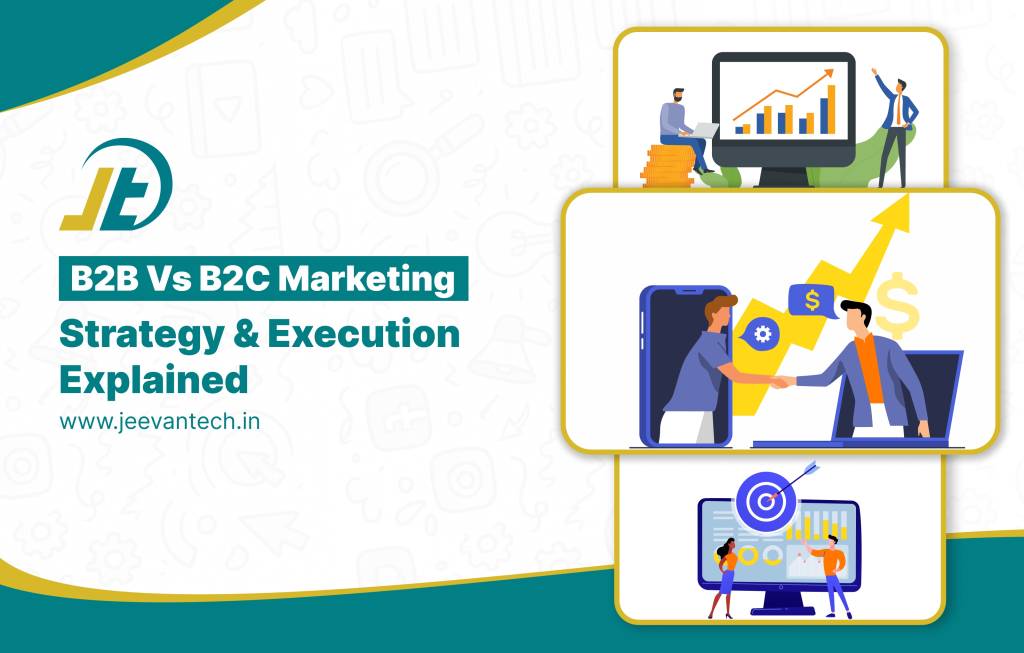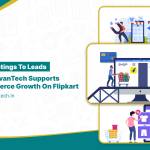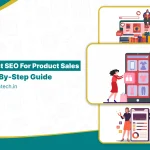In the digital age, marketing is no longer a uniform strategy. Two distinct approaches dominate the landscape– B2B and B2C Digital Marketing. However, both share a common goal of driving conversion and building brand value, yet they use different strategies. Let’s explore how B2B and B2C Digital Marketing vary across key areas like audience, messaging, content, platforms and execution.
Target Audience & Decision-Making
Understanding the target audience and how they make decisions is the backbone of any digital marketing firm. In B2B and B2C Digital Marketing , the audience profile and their decision-making process differ drastically, which is why the strategies must be tailored accordingly.
B2B Marketing :
In B2B, the target audience includes professionals, business executives and management teams. As a result, they all work together to analyze how an individual makes decisions based on logic, long-term value and return on investment(ROI).
B2C Marketing:
In B2C, the focus shifts to individual consumers. Their choices are often influenced by emotion, trend and personal needs.Consumer psychology plays a central role in B2C marketing– people buy what feels right, not necessarily what makes the most sense.
Content Strategy
The backbone of digital marketing is content– Nevertheless, how you create and deliver it varies based on whether you’re targeting businesses(B2B) or consumers(B2C). A well- defined content strategy makes sure that you are not just reaching the audience, but engaging them meaningfully.
B2B Content:
In B2B, content is created to educate, inform and build authority. Since the audience is looking for solutions to complex problems, your content must be rich in insights and data.
Common formats include:
- Long form content(eBooks, whitepapers)
- Case studies and LinkedIn articles
- Webinars, guides and FAQs
B2C Content:
In B2C Digital marketing is all about grabbing attention quickly and creating an emotional connection. The content should be fun, relatable and easy to consume.
Popular B2C content types:
- Short form content(Instagram reels, TikToks, memes)
- Promotion, giveaways and reviews
- Product videos and lifestyle photography
Sales Funnel & Customer Journey
The sales funnel and customer journey represent how a prospect becomes a customer. While both B2B and B2C Digital Marketing share this pathway, the structure, the length and strategy behind each journey are uniquely designed to their audience types.
B2B Sales Funnel:
In B2B marketing, the sales funnel is longer, more complex, and requires multiple levels of engagement before a decision is made.
- Awareness is created through educational content like blogs, webinars and LinkedIn posts.
- Consideration involves personalized emails, product demos and consultations.
- Decision-making includes stakeholder discussions, price negotiations and ROI justification.
B2C Sales Funnel:
By contrast, In B2C marketing, the journey from discovery to purchase is often short and emotionally driven.
- Awareness can be sparked by social media ads, influencer shoutouts or trending videos.
- Interest grows through product reviews, visuals and relatable content.
- Action is usually spontaneous– add to cart, checkout or sign up.
Platform and Channel Usage
Choosing the right platforms and marketing channels is very important to showcase your product to the targeted audience effectively. B2B and B2C businesses leverage completely different spaces online based on where their customers spend time and how they consume content.
B2B Marketing Platforms:
For B2B brands, the best platforms are those that support industry insights, networking and in-depth communication. These platforms are ideal for distributing high-value content and generating qualified leads.
- LinkedIn – The goal standard for B2B marketing, perfect for lead generation, thought leadership, and professional networking.
- Email Marketing – Highly effective for personalized messaging, nurturing leads and automating sales funnels.
- Industry Blogs and Forums – Help in SEO and establishing domain authority.
B2C Marketing Platforms:
In B2C marketing, the focus is on platforms that are visual, viral and highly engaged. These channels are curated for quick engagement, storytelling and impulse-driven action.
- Instagram – Great for visual storytelling, influencer marketing and product highlights.
- Facebook – Useful for community building, reviews and running targeted ads.
- Pinterest – A powerful platform for lifestyle, fashion and decor brands with strong visual appeal.
Messaging Style and Tone
The way a brand communicates defines how it’s perceived among the audience. In both B2B and B2C digital marketing, the message must be aligned not only with the brand identity but also with how the target audience prefers to receive information. While both styles aim to persuade, the tone and delivery significantly differ.
B2B Messaging:
B2B(Business to Business) messaging is typically formal and structured, with a focus on demonstrating value, ROI and expertise. The tone must reflect credibility, clarity and confidence to appeal to decision-makers.
B2C Messaging:
B2C(Business to Consumer) messaging takes a friendly and often playful approach. It appeals to emotion, lifestyle aspirations and instant gratification which makes the message more relatable and engaging to the everyday consumer.
Key Performance Indicators
Tracking performance is crucial in digital marketing, but B2B and B2C brands prioritize different metrics based on their business goals and customer behaviour. While both depend on data-driven strategies, the focus and depth of tracking differ greatly depending on the model.
B2B Marketing metrics:
In B2B marketing, success is not measured just by clicks– it’s about quality of leads, the sales pipeline and the long-term value of custom relationships. The buying process is longer and more considered, so performance indicators are tied together for strategic goals.
B2B KPIs:
- Lead generation and Lead quality
- Customer Lifetime Value(CLV)
- Cost per Lead(CPL)
- Conversion Rate from MQL to SQL
- Sales Cycle Length
- Return on Investment(ROI)
B2C Marketing metrics:
B2C brands focus on volume-based metrics like visibility, conversions and user engagement. The customer journey is often short, so performance is tracked in real-time to quickly identify what content or campaigns are driving action.
B2C KPIs:
- Click- Through Rate(CTR)
- Conversion Rate
- Customer Acquisition Cost(CAC)
- Website Traffic and Bounce Rate
- Engagement Rate(Likes, Shares, Comments)
- Repeat Purchase Rate
Comparing B2B and B2C Digital Marketing KPIs:
- In B2B Marketing, the focus is on high-quality leads, long-term customer and conversion rate. Metrics like Marketing Qualified Lead(MQL) to Sales Qualified Lead(SQL) conversions, customer lifetime value(CLV) and sales cycle length are prioritized to measure how effectively a company is nurturing relationships and drives sales-ready leads.
- B2B campaigns are often built around trust, credibility and relationship-building – making CRM integration and pipeline tracking essential.
- On the other hand, B2C marketing emphasizes real-time customer behavior and instant results. Key performance indicators include click-through rates(CTR), Conversion rates and engagement metrics such as likes, comments, shares and video views.
- Since the consumer journey is faster, purchase frequency and bounce rates become critical to track, helping brands understand what drives purchases and visits.
Overall, while B2B KPIs are rooted in strategic growth and lead quality, B2C KPIs focus more on reach, responsiveness and consumer behavior in the short term.




